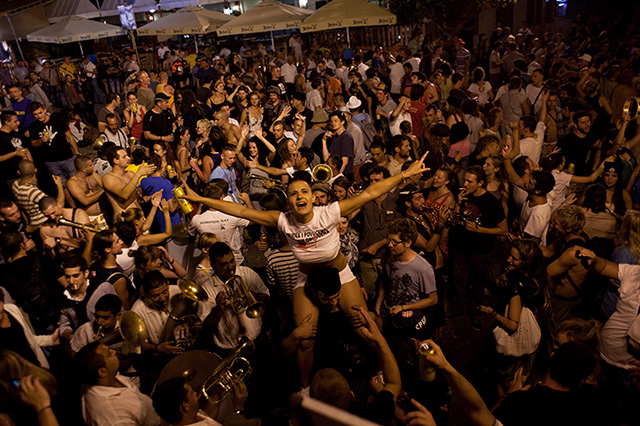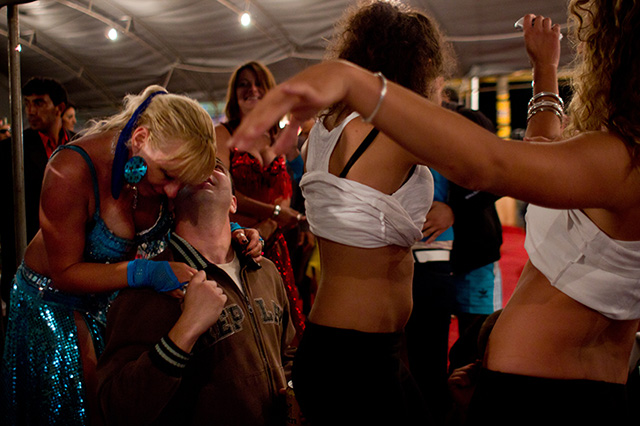(Photos by Anna Y. Loshkin)
It's barely nine in the morning and the sound of vuvuzelas fills the air. Shirtless young men have already had their first shot of the day, and the ones who haven't line up, bleary-eyed, at the convenience store for a fresh pack of cigarettes or a bottle of rakija, the plum brandy that flows liberally through this town. This is Serbia's famous Guča Trumpet Festival, a gathering of trumpet players, gypsy orchestras, Balkan music lovers, and young Chetniks—the latest embodiment of Serbian nationalism.
Advertisement
Among a sea of slogans like "Save water, drink beer" and "A blow job is better than no job," one T-shirt stands out—a portrait of former president Slobodan Milošević, "Your army waits for you" is written under his pensive face. Milošević is still infamous in Serbia for his role in the ethnic cleansing that took place in the 1990s during the Yugoslav Wars. Another T-shirt featuring his likeness reads, "You know, there are worse people than me." These are not ironic. People stroll around town with shirts announcing, "Thank God I'm a Serb," "Serbian Chetniks," and "Country of champions.” Some wear black shirts with a skull and crossbones, with the words "Faith in God - Freedom or death" in Church Slavonic script, with army-green hats adorned with the two-headed eagle topped by a royal crown. Welcome to Chetnik country.Every year in August, several hundred thousand people descend upon Guča, a sleepy village of 3,000 in Central Serbia. Guča, proclaimed "Europe's biggest, baddest summer music festival,” in the Guardian, attracts internationally known Balkan acts and a sizable portion of Western European attendees. But during this weeklong turbo-folk party, foreigners either don't notice the thinly veiled nationalism, or are too drunk to care.

It started out innocently enough in 1962. A bunch of trumpeters got together for a jam session in Guča, a bucolic village with a backdrop of lush green hills, mineral water springs and wildflowers in the Dragacevo region a few hours southwest of Belgrade. The "benevolent dictator" Tito was president, and the Croats, Montenegrins, Albanians Kosovars, Slovenes, Macedonians, Serbs, and Bosniaks had united into a heterogeneous nation called Yugoslavia.
Advertisement
Today everything is different. Following the bloody wars of the 1990s, Yugoslavia splintered into seven countries. In 2001, a brief wave of democracy led to the resignation of Milošević and election of opposition leader Zoran Djindjic. Milošević ended up on trial for war crimes in The Hague. Only two years later, Djindjic was assassinated, and, with him, the hope of progress and peaceful coexistence with Serbia's neighbors died.Since the election of Serbian nationalist president Tomislav Nikolić this May, many fear that Serbia's new path is not towards EU membership but instead a regression to the ethnic conflict that caused years of bloodshed. The recent appointment of Prime Minister Ivica Dačić has caused unease due to his close ties with Milošević.The mood in Guča fits in with Serbia’s current political landscape. "There is a difference between being a patriot and being a nationalist. Most of young people here don't know the difference and it often grows to be close to racism," says Margita, a 19-year old from a small town in the region. Indeed, there is a kind of innocence in the faces of the young guys and girls who proudly sing about Serbia's greatness, wearing hats with Chetnik regalia, their bodies draped with the Serbian flag. They all show the three-fingered salute: the thumb, index and middle finger out, and the last two bent in. Ostensibly this stands for the holy trinity—the father, the son, and the Holy Spirit. As with many things in the former Yugoslavia, the salute is controversial. Bosniaks and Croats find it offensive, a provocation even, as it was used by the same Serbian army that ruthlessly murdered their people. In Guča, people flash it to passersby, cameras, and each other. Just like the cross that hangs around people's necks, it has become a normalized symbol of Serbian pride.
Advertisement
Since the 90s, Chetnik iconography has become synonymous with Serbian nationalism. The movement itself is linked to the Serb-inflicted massacres, rape, and torture of the Yugoslav wars. In testimony at The Hague about the ethnic cleansing that took place during the wars, victims refer to the Serbian forces as Chetniks. One Muslim woman's testimony reads: "On the 25th of May the Chetniks attacked our village, which was a Muslim village, and by the 31st of May all the men from the village were taken to a concentration camp. … They killed en masse, pillaged and burnt our houses, detained women, elderly and children and burnt them alive."

Chetniks, which loosely translates as militia, started as a monarchist guerrilla force in the early 20th century. They took up arms as a royalist resistance group after the ouster of the royal family in World War II, at times collaborating with the Partisans and at times with the Axis Powers, fighting on the side of the Nazis. Just after World War II, as Josip Broz Tito took the reigns on Yugoslavia’s Communist government, Chetnik leader Draza Mihailovic was found guilty of treason and executed.For over 30 years Tito sustained a delicate balance in Yugoslavia and with allies on both sides of the Iron Curtain. After his death in 1980, nationalist sentiment began to escalate. In his 1992 book The Fall of Yugoslavia Balkan expert Misha Glenny writes: "The revival of the Serb nationalists, the Chetniks, has been one of the most hideous and frightening aspects of the collapse of communism in Serbia and Yugoslavia. This breed, which finds nurture in the perpetration of unspeakable acts of brutality, encapsulates all that is irrational and unacceptable in Balkan society."
Advertisement
Slobodan Milošević fanned the flames of religious and ethnic hatred in his 1989 speech at the 600-year anniversary of the Battle of Kosovo. This is where Serbian prince Tsar Lazar fought against the Ottomans in 1389 and died a hero. Despite Serbia's defeat and the subsequent 500 years under Ottoman and later Austrian rule, the location is considered holy. It's the birthplace of Serbian identity; Tzar Lazar is regarded as a martyr for his people.At Guča, young people from the countryside and beyond gather to listen to the call of the trumpet, dance to traditional folk songs, and shout slogans about Greater Serbia. Bellicose cries of "Kosovo will always be ours!" resonate from campgrounds, parking lots and groups gathered under the town's Golden Trumpet Player statue in the main square.I meet Jovan and his young son outside of Guča’s Center for Culture, where they were taking a respite from the heat and crowds. His son sat next to him, playing with a toy AK-47. "I've been to the US. I liked Miami but I don't like your politics," he shouts over the din of a religious concert a few meters away. Serbian attacks on ethnic Albanians in Kosovo led to the US-backed NATO bombing of Belgrade in 1999. Even though the sanctions were lifted in 2005, anti-Western sentiment is still strong. He shows his tattoos to me—a giant one of Tsar Lazar fills most of his right shoulder and bicep, and another covering his back, depicting the Kosovo Maiden comforting a dying soldier after the battle. The tattoo of this scene, taken from the eponymous Serbian epic poem, is one of many I will see in Guča. In Jovan's tattoo, Lazar is on a horse holding a shield which sports Serbia's coat of arms with its embellished 4 C's: Само Слога Србина Спасава – Only Unity Saves the Serbs. The same coat of arms decorates the Serbian flag.
Advertisement

From high on a hill I watch the young men below lather themselves up into a frenzy with their chants about Serbia's greatness. The singing has been going on for close to an hour, nurtured by beer and a lively audience. Farther down the road, traditional folk music is blasting from a van—a departure from the ubiquitous turbo-folk. A group of men have set up camp around the van, in a coveted corner of the field, where everyone who passes by will hear their music. Miroslav, the leader of the group, invites me for a beer and tells me that they have travelled from a Serbian stronghold in Kosovo especially for the festival.It's early afternoon and despite the sour expression on the face of one gentleman with a bandaged head and a black eye, the party is in full swing. The men are swaying to the music, and one of them dances on the roof of the van. He's shirtless, a little drunk, and a thick chain with a cross dangles from his neck. Miroslav lectures in passable English, "America doesn't understand the Albanian threat. They are terrorists, like in Iraq. My brother was killed in the war there. Kosovo is Serbian!" He adds, "The Albanians are organ traffickers."Several dozen trumpet orchestras play and compete for prizes at Guča, but it’s mostly the gypsy ‘orkestars’ who roam the town’s streets, serenading the masses for tips in bars and restaurants. Ironically, these same gypsy bands also play nationalistic songs for an eager audience. In another twist, the traditional Jewish melody “Hava Nagila” has become a Guča anthem of sorts, played countless times alongside Goran Bregović's “Kalashnikov” and “Gas Gas.”
Advertisement
"Guča is a special week,” says Miroslava, a French-Serbian beauty who has been dating a trumpet player from a Gypsy band since last year. She hasn't told her family yet, and neither has he. "We are like Romeo and Juliet. It's not acceptable for me to be with a Gypsy, or for him to marry a Serb."Since the collapse of Yugoslavia, Serbs have embraced the glory of their monarchist past. Despite losing all four wars Serbia has started since 1990, the obsession with a Greater Serbia for the Serbs persists almost 15 years later. "In Serbia, it's all about choosing sides," Margita tells me.My friends in Belgrade say that turbo-folk loving nationalists go to Guča and civilized people go to Niš, a nearby town where the international jazz festival is held around the same time. In this fragmented region with a mixed ethnic population, such a divide represents a real threat to stability. Do the displays of nationalism at Guča arise from the heady atmosphere and a desire to belong? Perhaps. It could just be a passing phase for young people. But this youthful transgression has been legitimized by the new Serbian government.